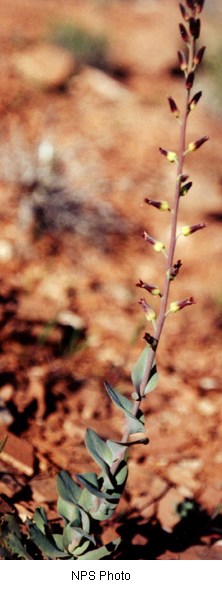
Streptanthus cordatus Family: Brassicaceae (A Utah Flora - Cruciferae) – Mustard Family Perennial herbs from taproot; 7.1” to 2.6' (1.8 to 8 dm) tall Leaves: alternate and basal; simple; entire to toothed margins; wide bluish-green basal leaves spatula-shaped that clasp the stem; 0.6” to 6” (1.5 to 15 cm) long, 0.2” to 2” (0.5 to 5 cm) wide Flowers: 4 purple to chestnut petals in the shape of a cross or crucifer; 4 sepals; usually 6 stamens; 1 pistil; flowers in corymbs or racemes; usually radially symmetrical; petals 0.4” to 0.58” (10 to 14.5 mm) long; nectar glands commonly 4 Pollinators: other genera in this family are pollinated by insects (specifically butterflies, moths, bees and flies); some self-fertile Fruits: silique - a pod with 2 compartments with a thin partition Blooms in Arches National Park: April, May Habitat in Arches National Park: desert shrub and pinyon-juniper communities Location seen: park road mile 11 to 12 and mile 15.7 Other: The genus name, “Strepanthus”, is from the Greek “streptos” meaning “twisted” and “anthos” meaning “flower” and refers to the twisted petals of the flower. The species name, “cordatus”, means “heartlike” and refers to the heart-shaped base of the upper stem leaves. Many plants in this family are weeds and they flower early because they are annual. Many vegetables are in this family– radish, cabbage, cauliflower. A few species of plants in this family are poisonous to livestock. |
Last updated: February 4, 2023
